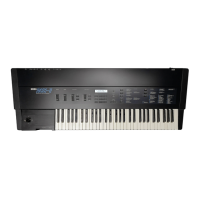3. Using the System
■ The DSS-1 handles the following information as system exclusive mes
sages.
Data that can be trans m itted an d re ce ived .
The DSS-1 sends data upon receiving particular request messages, The DSS-1
also changes parameter sellings upon receiving particular data.
MULTISOUND LIST : A list of multisounds iri the DSS-1 syslem.
Sent when a SOUND LIST REQUEST
message is received.
MULTI SOUND PARA
METER DUMP
PCM DATA DUMP
PROGRAM PARA
METER DUMP
The parameter data for one multisound In
the DSS-1 syslem, This is used, for in
stance, when computing PCM data ad
dresses.
Sent when a MULTISOUND PARAMETER
REQUEST is received
Refers to PCM data within the specified
area of DSS-1 PCM data memory. Sent
when a PCM DATA REQUEST message is
received
Refers to data for a single program in pro
gram memory. Sent when a PROGRAM
PARAMETER DUMP REQUEST is receiv
ed
If Lhe DSS-1 receives this data, it stores it
in the program output buffer (not directly
in program memory).
Data th at ts on ly tra nsm u ted .
This data is sent upon receiving particular syslem exclusive messages.
DEVICE ID : Name cf device, sent when DEVICE ID
REQUEST is received.
MODE DATA ; Data indicai in g DSS-1 mode, sent when
MODE REQUEST is received.
PROGRAM NAME LIST : The program name list from program
memory, sent when a PROGRAM NAME
LIST REQUEST is received.
DATA LOAD COMPLETED : Indicates successful reception of dale. A
response to MULTISOUND LIST, MULTI-
SOUND PARAMETER DUMP, PCM DATA
DUMP, or PROGRAM PARAMETER
DUMP
: Indicates a problem with data reception. A
response to errors In the format or chek-
sum.
: Indicates successful completion of pro
gram write operation. A response to a
WRITE REQUEST,
: Indicates that the program write was not
performed because the WRITE REQU
EST program number was not within the
range of 0 to 31. A reply to a WRITE RE
QUEST.
DATA LOAD ERROR
WRITE COMPLETED
WRITE ERROR
Data that is on ly rece ive d .
These are "request messages1' which ask the DSS-1 for information or cause a
change in some aspect of DSS-1 operation.
DEVICE ID REQUEST : A request for the DEVICE ID of the receiv
ing device.
PLAY MODE REQUEST : Changes DSS-1 mode to the play mode.
Exclusive Messages
MODE REQUEST
A request for MODE DATA
MULTISOUND LIST
REQUEST
MULTISOUND PARAMETER
REQUEST
A requesl for the multisound list.
A request for a mullisound parameter
dump,
PCM DATA : A
REQUEST
PROGRAM NAME LIST
: A
REQUEST
PROGRAM PARAMETER
: A
REQUEST
request for a PCM dala dump
request for the program name list.
request for a program parameter dump,
PROGRAM PARAMETER
CHANGE
Change parameter values in ihe program
outpui buffer
WRITE REQUEST : A request to wrlie dala from the program
output buffer to program memory. De
pending on the program number received,
Ihe response will be WRITE COMPLETED
or WRITE ERROR.
■ Using these syslem exclusive messages you can exchange dala wi|h a
computer equipped with a MIDI interface and suitable software.
■ Connections are as shown here.
■ DSS-1 exclusive messages use Ihe send/receive channel numbers deter
mined by MIDI mode F1 CHANNEL SELECT. These must malch on the
computer in order to send and receive system exclusive messages.
Messages on the wrong channels are ignored. (They are not affected by the
channel mode message OMNI mode.)
Important Note: Unprediciable behavior may result if you send data to
the DSS-1 that is outside the specified bounds. Check
your dala if slrange things are happening. There could
also be bugs in the software.
:■ The DSS-1 musi be in the PLAY MODE for transmission and reception of
system exclusive messages other than reception of DEVICE ID REQUEST,
transmission of DEVICE ID, reception of MODE REQUEST, transmission of
MODE DATA, and reception of PLAY MODE REQUEST.
■ When the DSS-1 is not In the play mode but Is in a mode from which it can
switch into the play mode, then a PLAY MODE REQUEST can be used 1o
change It to the play mode. After doing this you should transmit a MODE
REQUEST to confirm the play mode and then go ahead with transmission
and reception of the system exclusive messages.
■ When transferring MULTiSOUND LIST and MULTI SOU NO PARAMETER
dala to the DSS-t. it is necessary for the two to have the same NUMBER OF
MULTISOUNDS, MULTISOUND NAME, and MULTI SOUND LENGTH
■ The MULTISOUND LENGTH is used to find the absolute address for PCM
data. Therefore, be careful when changing the MULTISOUND LENGTH if
there are several multisounds resident In the DSS-1.
,307
MIDI MODE

